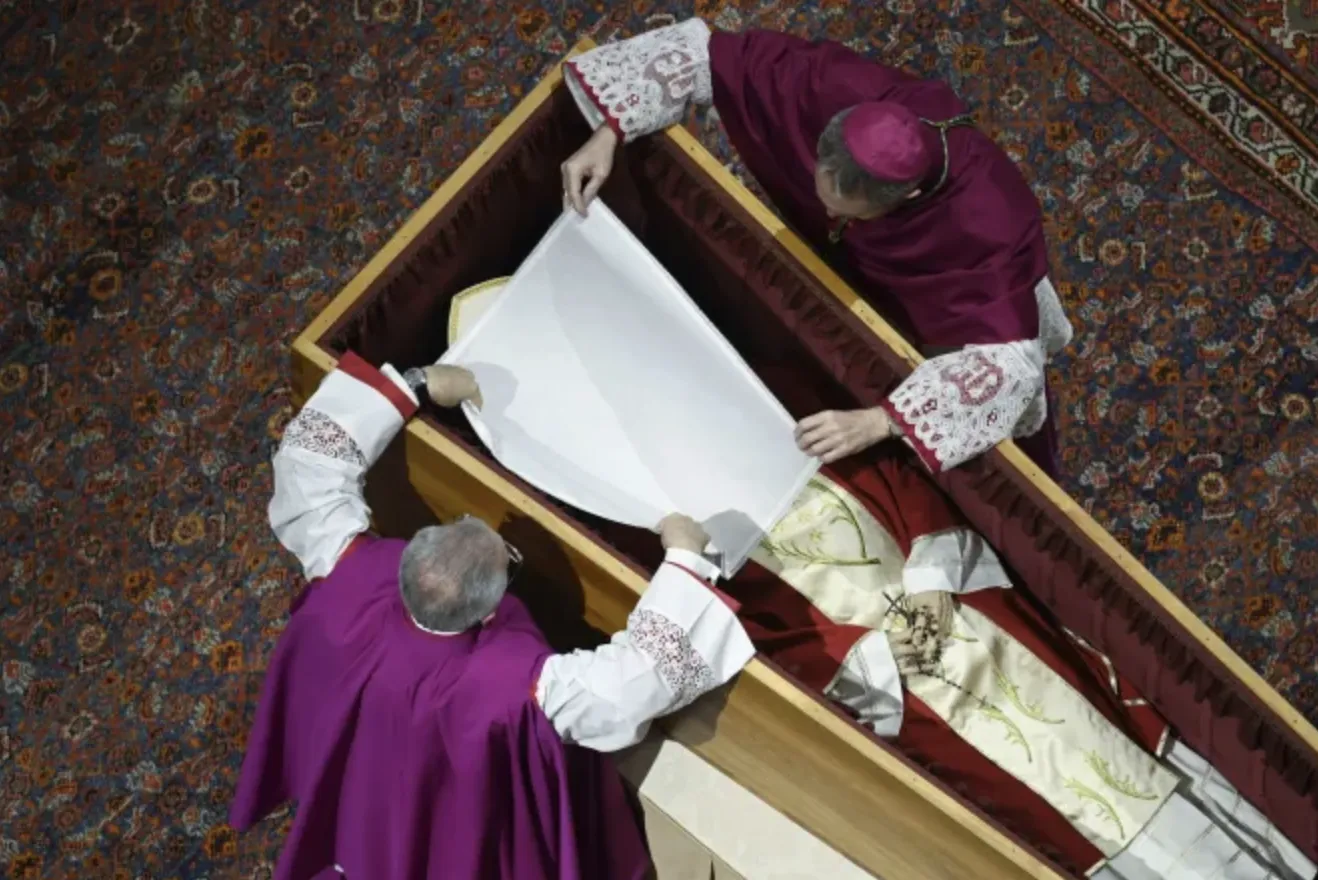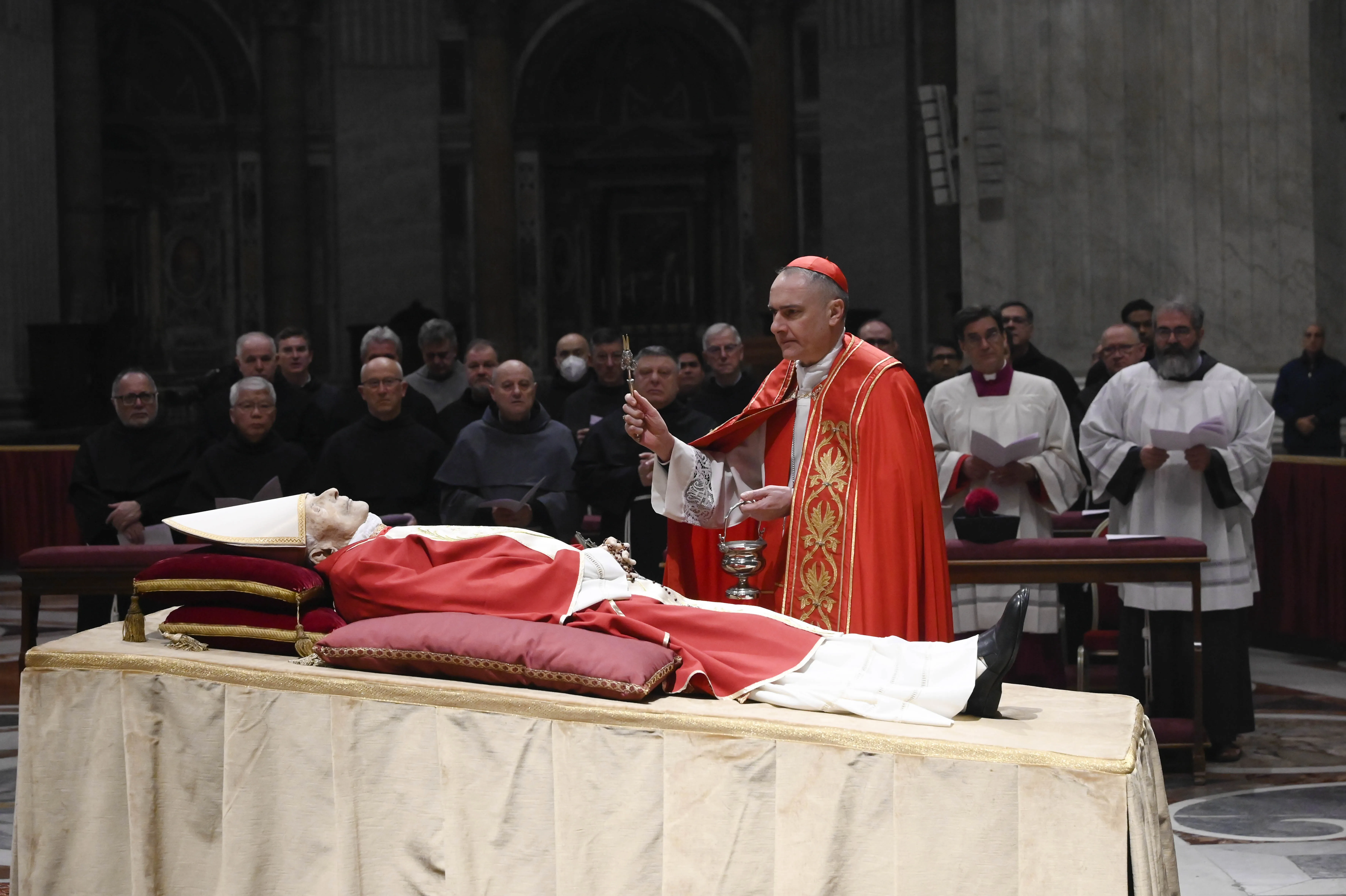
Vatican City, Jan 6, 2023 / 00:01 am (CNA).
There is no doubt that the funeral of Pope Emeritus Benedict XVI on Jan. 5 was a pope’s funeral. Not only was the funeral rite the one foreseen for the death of a pope, but so were all the rites that accompanied it.
For example, the medals and coins of the pontificate, the “rogito” (the brief document describing the pontificate), and the palliums that characterized his activity — that of archbishop of Munich, that of dean of the College of Cardinals, and that of pope — were buried with Benedict in the coffin, as is customary for a pope.
Also, the celebration was the classic one of the pope’s death, except for the abolition of the supplication of the Diocese of Rome and that of the Eastern Churches. Both of these pleas, in fact, specifically concern the death of a reigning pope and would not have been indicated for pope emeritus.
The funeral rite for Benedict XVI followed that which was reserved for Pope John Paul II on April 8, 2005. However, there were slight differences, such as the decision not to use the Roman Canon, the most ancient Eucharistic Prayer of the Roman Church, which until now has always been the custom. Instead, Eucharistic Prayer III was used.
In every single gesture, it was demonstrated that Benedict XVI was a pope of the Catholic Church and that his pontificate is part of the history of the Church.

On the other hand, Benedict XVI’s resignation differs from the other six resignations from the pontificate that have taken place in previous years. The only one of these perhaps comparable was that of Celestine V, Pietro di Morrone, who returned to being a monk until the end of his life. However, Benedict XVI has opened up a new path: It is the first renunciation of a pope made not because he was under pressure or incapacitated but because he was lucidly aware that he no longer had the strength to carry forward the boat of Peter.
For this reason, the funeral of Benedict XVI was the funeral of a pope, but it is not the funeral of a pope who died while reigning. And this can be seen in many details.
First, there is no “sede vacante,” and therefore there are no rites of “sede vacante.” Those were already done at the end of the pontificate, on Feb. 28, 2013, when Cardinal Tarcisio Bertone, then Camerlengo, went up with the members of the Apostolic Camera to the papal apartments to celebrate the rites at the end of the pontificate: the breaking of the fisherman’s ring, the seals affixed to the papal apartment. Even then, there hadn’t been a crucial step: the confirmation of death.
At the death of Benedict XVI, however, there was a reigning pope. Therefore, all the power of jurisdiction fell on the reigning pope and, consequently, on the Secretariat of State of the Holy See.
From a formal point of view, the certification of the death was made by Pope Francis himself, the first to be warned by Archbishop Georg Gänswein and rush to Benedict’s bedside after he died.
The announcement was then made with a statement from the Holy See Press Office. This body disseminates official information from the Holy See, receiving it from the Secretariat of State.
When a reigning pope dies, in contrast, the announcement is made from the Apostolic Palace. It is proclaimed by the pope’s vicar for the Diocese of Rome — even if, on the death of John Paul II, it was the then deputy of the Secretariat of State, Leonardo Sandri, who announced the end of the pope.

The absence of official delegations at Benedict’s funeral was another feature that carried a certain weight. If the pope is reigning, there are only official delegations. In this case, it was preferred to clarify that the pope is emeritus by emphasizing that any participation by heads of state, monarchs, or government members would be in a personal capacity.
All of this happens because there is a “see plena,” with all the powers, which are those of the pope. Therefore, the heads of dicasteries have not ended their mandate at the death of Benedict XVI because the pontificate has not ended. And the Camerlengo of the Holy Roman Church has not taken power because the pontificate has not finished.
Cardinal Kevin J. Farrell, Camerlengo, was not present when the casket was closed on Jan. 4.
Instead, there were:
- Cardinal Giovan Battista Re, dean of the College of Cardinals;
- Cardinal Mauro Gambetti, archpriest of St. Peter’s Basilica;
- Cardinal Angelo de Donatis, the pope’s vicar for the Diocese of Rome;
- Cardinal Fernando Vergez, governor of Vatican City State;
- Archbishop Edgar Pena Parra, substitute of the Secretariat of State, and
- the canons of St. Peter’s.
When the body of Benedict XVI was transferred to St. Peter’s Basilica, the prayer was led by Cardinal Gambetti and not by the Camerlengo because the Holy See was not vacant.

It is these details that help to understand that it was the pope emeritus and not the reigning pope who died. Not even the bells of St. Peter’s rang to announce the death of Benedict.
There was no mourning day, and mourning was not officially proclaimed for the Vatican city-state even on the day of the funeral, though many Vatican employees attended the liturgy.
In other words, ceremonial signals were sent to make clear that Benedict XVI was not the reigning pope.
At the same time, there was no doubt that Benedict XVI was pope and that he should have a pope’s funeral.
In the same way, it must be considered that it is as if the pope’s death had occurred twice: first, at the resignation, during which the “sede vacante” began, and a conclave took place to elect the successor, and then at Benedict’s actual death. In other words, the funeral was the second half of a celebration that began with the vacant seat on Feb. 28, 2013.
In the end, Apostolici Dominici Gregis, John Paul II’s constitution that regulates the procedures after a papal death, states the funeral rites of the deceased pope must be “celebrated for nine consecutive days, determining when they are to begin, in such a way that burial will take place, except for special reasons, between the fourth and sixth day after death.”
Following these norms, Benedict’s funeral was celebrated within that time period. However, there will not be formally nine consecutive days of mourning, although Masses in suffrage of Benedict XVI’s soul will be celebrated.
Finally, a curiosity: Benedict XVI did not wear the fisherman’s ring, which was broken at the end of his pontificate, as a procedure. He was wearing instead the ring of St. Benedict, which replicated the symbols of St. Benedict’s medallion, symbolizing his unique link with the saint from Nursia, co-patron of Europe.
If you value the news and views Catholic World Report provides, please consider donating to support our efforts. Your contribution will help us continue to make CWR available to all readers worldwide for free, without a subscription. Thank you for your generosity!
Click here for more information on donating to CWR. Click here to sign up for our newsletter.




Leave a Reply